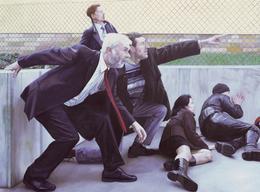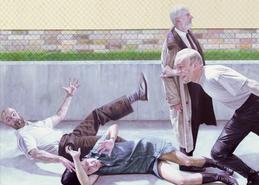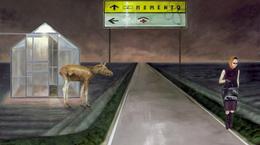Focused Contingency
The Berlin journalist Tom Mustroph describes 15 years after the wall came down in his essay the Leipzig painter Aris Kalaizis and his hunt for images, the time in the GDR as well and his love to soccer

Aris Kalaizis is a master of the enigmatic. Part of his mastery lies in his ability to lull the viewer into a sense of security. The details of his paintings are taken from everyday life. They appear harmless: a concrete wall, a patch of grass, a piece of woodland, semi-transparent glass panes, and between these objects normal people. From these elements, Kalaizis, just like a demiurge, creates worlds that we seem to know and believe to populate. Yet they exhibit an intensity, an aura, even a creation of the secret and the threatening, which we think we have erased from our everyday life – and which confront us here in the guise of the banal. Broad Street No. 100 (2005), for example. A lobby of an office building. A security guard stands in front of an elevator. His hand points roughly in the direction of the elevator. Perhaps he is showing someone the way, gesturing for someone to go on. At second glance, the viewer realizes that the security guard is studying his hand. What is he looking for in his hand? Perhaps he wants to read his own palm. Does he miss the gun which his hand had held? Did someone steal it from him…and he still cannot believe it? What about the figure on the left? The viewer sees only a leg, two feet, an arm. The figure appears limp. Has the life been drained from him? Does this person’s state have something to do with whatever the security guard is missing? Is this a crime scene? Where is the culprit? The scene, the place where the events must have occurred, is deserted. No clues are left behind on the floor, which is abnormally clean. Reflections shine on the wall. Are they signs?
Is it possible to recognize something in the reflection? Unconsciously, the viewer steps into the picture and tries to analyze the relationship between the figures and to find meaning in the objects. You can do this for a while but will not arrive at a final conclusion. On the contrary, you will grow only more confused, for you will suspect that everything you interpret in the places and in the relationship between the figures comes from you, the viewer. As the viewer of Kalaizis’ stage-like composition, we see that which we want to see and that which we fear to see.
The painter himself refrains from describing his pictures and explains convincingly that he is not after finesse. “My work is of a formal nature”. The composition is controlled by form, not by the subject matter, not by staging.” But why do Kalaizis’ paintings call the viewer to engage in the act of deciphering? And why, above all, do they expose the viewer’s attempts to decipher as systematically futile but at the same time call for these attempts again? Why is this process triggered so massively by his works, and not by those of any other painters?
In Kalaizis’ works we find ambiguity, a play on reflections and reciprocal illusions, a meandering erosion of the fundamentals of that which we consider to be safe, just as Thomas Pynchon masterfully expressed in his works. In order to understand the layers of Kalaizis’ works, I find it necessary to recall a series of encounters with him.
Encounter I
In the beginning, it was an assignment. A call from the editorial department: “Go to this new gallery in Charlottenburg and look at this. A young painter from Leipzig is showing his work there. He’s going to make it big someday.” A freelance journalist doesn’t ignore this kind of advice from an editor – after all, since the mid-nineties the Leipzig School has reached worldwide acclaim. And so on the way to Buckow – Brecht’s Buckow, that is – for a weekend getaway, I make a quick stop-over in the Quicksilver Gallery. A quick stop-over?
A group of paintings, some still lying on the floor, some only temporarily labeled – the exhibit Brancard (2003) will open on this evening – grabs the viewer’s attention.

Concrete ground, waist-high concrete wall, a chain-link fence on top of it. On the ground are two people, who have just fallen, their hands held out as if to protect themselves. A man quickly rushes as he steps over them. He still has the entire width of the canvas Fargo II (2002÷2003, 55 x 69 inch) to cross. The eyes of the woman lying on the sidewalk attempt to catch the eyes of the fleeing man. Does she want to read his mind by looking into his eyes? Is she sending out a warning not to approach her? Her companion, who is lying next to her, is looking out of the picture and in the direction in which the man is hurrying. What could he possibly see there? A threat? A victim? The cause of the catastrophe? Is the fleeing man a hero? A criminal? An undercover policeman?
A different scene The Great Hope (2002): Again concrete ground. A green brick wall of an industrial building. A steel door. A man sitting on the ground with his back against the door. Presumably a tramp. He throws an orange plastic bag to a woman whose short black coat, which she has thrown over her white undergarments, unveils her instead of covering her. It’s a call for attention, an offer of protection, at the same time a proposition. Immediately the conditions of destitution and impoverishment, in which both figures find themselves, become apparent.
Brecht’s lovely Buckow – the cozy weekend – at once this is all forgotten. My girlfriend, still sitting in the car, hadn’t slipped my mind – I wanted to run upstairs and have a quick look – but she’d have to wait. For more canvases are calling for my immediate and absolute attention. Fargo I (2002), for example. It does not explain the source of confusion in “Fargo II”, as one might assume considering the title, nor is it a precursor to Fargo II; rather, it is much more a different episode, a variation of the theme. The viewer recognizes three protagonists, although in different clothing. Two of them crouch on the ground, mechanically seeking shelter behind the waste-high concrete wall. One, standing upright, gazes into the distance, his eyes following the pointing finger of a new figure. A threat, a sudden change in the condition is felt. However, one cannot directly observe the change, but instead must read it in the faces and the posture of the standing figures. We have a choir in front of us, a kind of ancient choir who looks over the wall of the city and announces to those remaining in the Agora what approaches them, what threatens them, what might pass by them. Only the choir does not sing. Its formation, in which individuality was non-existent, has dissolved. Excitement has quieted the choir; it has disbanded into individual figures. What these figures see has immediately taken control of their bodies, has entered their bodies, and carries out each struggle. We are the witnesses of all of this and we try to make sense of it.
Buckow has been lost in a distance; what should one do in a lovely countryside, overly depicted by admirers of Brecht, who has been interpreted a million times and over decades of theater performances? In comparison, miniscule is the time span that the viewer devotes to these barely dry canvases, which is in itself miniscule in comparison to the time that the painter spends in front of a painting. One feels compelled to devote an equal amount of time deciphering motives, lines, the story of its coming into existence, and constellations for each painting. Buckow can wait.
Kalaizis, so it emerges, paints movies. He never copies them. For example, where in his Fargo paintings is the snow of North Dakota, which is the sign of all-encompassing loneliness in the film of the Coen brothers, and which connects at the same time in its all-encompassing nature each disparate life in a hostile-friendly way? The painter’s snow is concrete, chain-link fences, and enclosed lawns. At least in Europe, in Leipzig, where the lawn automatically ends at a chain-link fence.
Just as Kalaizis does not extend the film onto the canvas, his paintings are not still movie pictures taken from the flow of time. They are too pure, too constructed for that. There is no crack in the concrete. There are no cigarette butts, no cola cans, no dead birds lying on the ground. The reality is not realistic; rather, it is abstract.
This first impression becomes stronger during our conversation. The painter, who is busy hanging his paintings for the exhibit, explains that he creates primarily from his immediate environment. However, he reduces the abundance of details, which he finds on the way from his apartment to his studio, to a few elements. Leipzig’s picturesque decayed factory architecture is no longer recognizable. The scenery comes across as cool, clear, and staged. Somewhat artificial,”plain in an American way”, as one likes to say in Europe.
The design process takes place slowly, reveals Kalaizis. First he goes on the search for pictures. He hunts down forms and then captures them with his camera. He then separates and sorts his “catch”. Finally he chooses a photograph that contains nothing but the bare essentials. He declares it as the base of his constructed fantasy and hangs it above his bed. And he ponders. And he dreams. And he sleeps. In his mind he experiments with visual axes, light relationships, colors, the relationship between sharp and soft forms. A constellation, which will often become populated, emerges rather unconsciously. But not by persons – that’s where the viewer often misinterprets the painter; rather, by forms. They resemble persons: for example, a friend, a critic, a colleague, his gallerist, his wife. However, it’s not about persons; it’s about elements, torn from everyday life, isolated and kept in his mind as schemata, which he later brings into the context of a painting. Their presence in the painting allows them to be forgotten as pure form. But maybe one is still too influenced by Brecht, by figures placed in structures of power, who are protagonists of orders with their flesh-filled principles, and who are not just forms.
Encounter II
A second meeting, shortly before Kalaizis' first big show Uncertain Pursuits (2005, Marburg) is marked at first by a more personal exchange. We realize that we are almost the same age, that we both loved soccer earlier in our lives – we always stuck with the small teams, the rebels, the ones without money (Chemie Leipzig and Union Berlin). Yes, we probably were even at crucial matches in the same city, in the same stadium, only on different sides. We both experienced East Germany, grew up in East Germany with all the securities which no longer exist and with all the limitations which were imposed on us – and a few new ones have taken their place, but I will leave this discussion out of this catalogue. Aris Kalaizis grew up the son of Greek emigrants, the son of children who were brought to East Germany by parents who feared for their lives during the Greek Civil War. Although integrated, they were representatives of another culture, a culture that others often secretly admired, a culture which could not truly exist. However, it existed through memories, and – they discovered after 1989 – the culture as they lived it in East Germany had distanced itself from the native Greece, which had changed over time. One is apt to retrieve this position of the uncertain, the introverted, the secretive contemplator in the work of the son of the emigrants. However, this would be considered too deterministic, for it understands man in his complete and contradictory molding and sees the artist as the skeleton of the social structure.

We talk some more about movies: Fargo of course; The Matrix with its interlocking of time and space; David Fincher’s Seven with its dismal allegories; and Memento, Christopher Nolan’s thriller, which Kalaizis talks about excitedly. Automatically we get to the topics of gaps, uncertainty, and ambiguity. Good film directors define the uncertainty, which they leave to their viewers’ wild interpretation. As do good painters. The ambiguities in their work are however not omissions; rather, they are contingencies, double meanings, overlapping rules. Kalaizis describes hesitantly how he constructs his pictures, how he looks at visual axes, incidence of light, and perspectives. Every detail, whether a stone or a blade of grass in the background, whether a crease in the clothing or the figure’s posture, is the result of a strict thinking game.
The intensity of every detail is based on the intensity of this activity. It is charged with an abundance of determination, which invites us, the viewers, to find our way into the depths.
Encounter III
It is rare to witness the work of a contemporary artist in the making. The art market – a necessary instrument for the livelihood of painters and the gallery infrastructure – separates the paintings and hides them from the public eye. Especially the earlier works, most of the time rarely published, sometimes bashfully hidden, sometimes transfigured to a legend, elude an investigation. Retrospectives are therefore essential, even if the word sounds lofty to an artist not even 40 years old (at that time), who moreover hasn’t even been in business for a decade yet. The show Uncertain Pursuits (Kunsthalle Marburg, 2005) showed a painter influenced by the flesh, by the substance of things. A young artist impressed by the force of a Francis Bacon, but who also wanted to experience painting the monumental nature of flesh, that of humans and of animals, himself.
The art student launched into disemboweled animal cadavers and detached human body parts. However, he does not revel in orgies of blood and organs. Already in 1995, Kalaizis, incorruptible, sorts objects according to similarities in color and form and presents them clinically on an anatomical altar Triptych Title as yet unknown to the artist (1995). In doing so he places emphasis on contrast as a creative element. The montage remains visible as a montage, especially when Kalaizis separates his paintings into diptychs and triptychs. Uncertain Pursuits also introduced an artist who learned at the Leipzig School – where else? – to distrust the illustration process. His works are composed from the most varied sources. Decorative designs, antique lettering, elements from pattern charts, vignettes and the aforementioned raw pieces of meat are superimposed in his works from 1999/2000. They are the expression of a universal search for meaning. With a fine stroke, outlined human bodies are confronted with illustrations from science, popular science, and kitsch. Kalaizis studies athletes’ bodies, referring to the Deutsche Hochschule für Körperkultur, the Leipzig School of Sports, which achieved international standing in the seventies and eighties.
A key work of this time Practicing for the mastery (1999). Four different layers of painting come up against each other: the realistic portrait of a stark naked mother with her child; the discolored, almost washed-out back side of a man; a spot of dirty gray that seems to extends from the hand of this man; and a light ray, which travels through the other objects and connects them, but also changes itself. “Practicing for the mastery” is a self examination. It contrasts the mother-child figure with the incessantly isolated everyday life in front of the canvas. However, the silhouette of the painter grows into the space that contains the mother and child. He is present in the space, while his arm reaches with his paintbrush into the studio and stoically performs his necessary task.
We have met three of Kalaizis’ schools: the narration of postmodern cinema that is split in time and space; the monumental nature of flesh of a Francis Bacon; the layering of paintings of a Sigmar Polke. Jusepe Ribera must also be mentioned. Kalaizis admires the Spanish Baroque painter’s dramatic figure constellation, the struggle for a way out of a dismal beginning, and the immediate promise. For Kalaizis, the passion of the Baroque translates into melancholy. Each person struggles alone, looks inside himself, whether it be the man thrown out of the house in The House (2005) or the five figures in The hour of the inimitable revelation (2005). In each person is hope, in each is apprehension.
Has Kalaizis now been “explained”? I hope not, for the greatest activity is to allow yourself to be captured by the paintings and to find your way into them every day all over again until you, the viewer, have done justice to the activity.
©2006 Tom Mustroph | Aris Kalaizis
(Source: monograph ‚Rubbacord’, Kerber-Ed. 2006)
Tom Mustroph, freelance author lives in Berlin and Palermo